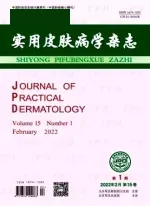增生性瘢痕和瘢痕疙瘩药物注射治疗进展
陈 卫,杨蓉娅
增生性瘢痕和瘢痕疙瘩有着不同的临床表现及预后,但均有组织修复和再生的调节机制出现障碍,从而导致创伤修复出现异常的纤维化的特点。目前,增生性瘢痕和瘢痕疙瘩的治疗尽管有多种方法可供选择,但局部药物注射治疗一直以来被广泛的应用与研究,且治疗效果确切;同时,研究表明,局部药物注射治疗与其他疗法联合应用则治疗效果更佳。本文主要就常用的注射治疗药物及研究现状进行综述。
1 糖皮质激素类
糖皮质激素是公认治疗增生性瘢痕和瘢痕疙瘩有效的激素类药物。曲安奈德注射液(triamcinolone)是最具代表性和最常用的糖皮质激素,可通过抑制成纤维细胞增生,促进胶原降解而改善瘢痕外观;同时,能抑制转化生长因子-β1(TGF-β1)的表达,诱导成纤维细胞凋亡[1]。
Park 等[2]在患者受伤后立即在创口周围注射曲安奈德注射液,分别进行1 个月和2 个月随访,结果发现增生性瘢痕的复发率降低76.5%。有研究认为,注射治疗前,在瘢痕边缘用2%利多卡因和0.25%布比卡因混合注射液进行皮下注射,能够明显降低糖皮质激素注射引起的疼痛[3]。
2 氟尿嘧啶(fluorouracil, FU)
FU作为一种抗肿瘤药物,主要作用是抗细胞代谢,降低胸苷酸合成酶活性,抑制正常DNA 和RNA 功能;同时,FU 还能够抑制TGF-β 的信号通路,而TGF-β 的表达在Ⅰ型胶原合成中起重要作用。实验研究证实,FU 能够诱导成纤维细胞的凋亡,这些研究结果对将来应用FU 预防瘢痕形成有非常重要的意义[4]。
目前,FU 通常用于治疗糖皮质激素治疗无效的瘢痕,但这两种疗法的疗效直接进行比较的研究资料缺乏。FU 对于不同时期的瘢痕治疗效果也不尽相同,对新鲜瘢痕疗效较明显。在一项双盲随机对照试验中,对曲安奈德和FU 注射治疗增生性瘢痕的疗效进行比较,结果发现FU 的疗效更加明显,且患者对治疗的满意度更高[5]。
3 维拉帕米(verapamil)
维拉帕米对瘢痕的治疗作用机制主要包括:①减少细胞外基质形成;②增加成纤维细胞前纤维合成;③抑制白细胞介素(IL)-6、血管内皮细胞生长因子(vascular endothelial ceu growth factor,VEGF)和成纤维细胞的增生;④抑制TGF-β1 表达、诱导细胞凋亡。⑤在瘢痕中核心蛋白多糖的含量下降[6]。研究发现,在动物瘢痕模型中同时注射曲安奈德和维拉帕米能够增加核心蛋白多糖的表达[7]。虽然注射曲安奈德和维拉帕米对瘢痕均有一定的治疗作用,但维拉帕米的不良反应较低[8]。
4 丝裂霉素C (mitomycin C)
目前,关于应用丝裂霉素C 皮内注射治疗病理性瘢痕的研究较少,结果尚存争议。有研究认为,在病理性瘢痕治疗中,短期使用丝裂霉素C 能够抑制成纤维细胞增生、降低成纤维细胞的密度[9];而Seo和Sung[10]研究发现应用丝裂霉素C 局部注射治疗瘢痕后,瘢痕局部出现恶化和溃疡,提示治疗无效。
5 联合治疗
在瘢痕治疗中,由于每种方法的治疗机制各不相同,且尚无一种单独应用而效果极佳的治疗方法;因此,为了达到最佳治疗效果,通常采用联合治疗的方法。曲安奈德注射液与FU 联合应用是最常用的联合治疗方法,Davison 等[11]和Darougheh 等[12]研究认为这两者联合应用的治疗效果比单独应用疗效明显提高。此外,曲安奈德注射液还可以与冷冻和激光治疗联合应用。Fitzptrick[13]报道,3 种以上方法的联合治疗效果比2 种方法联合治疗的效果更好。
6 展望
目前,仍有许多注射药物正在进行临床前研究,如①A 型肉毒素,能降低瘢痕硬度,使瘢痕柔软,并能改善红斑和瘙痒症状[14,15]。②己酮可可碱(pentoxifylline),一种甲基黄嘌呤衍生物,皮内注射能改善瘢痕弹性[16]。③米诺环素,注射治疗瘢痕动物模型时,瘢痕可缩小85%。④胶原-糖胺聚糖聚合物,用于人胸部瘢痕治疗也取得明显效果[17]。
直接能治疗瘢痕的药物一直都是广大医生和患者期盼的,这类药物也正在研究探索中,如:①阿伏特明(avotermin)和人重组TGF-β3,术后皮内注射能明显减轻瘢痕形成,目前正在进行临床试验[18-20]。②TGF-β3 是TGF-β 家族的亚型,有研究认为它能够对抗TGF-β1 的作用,减轻过度纤维化、炎症及胶原过度沉积,促进创口无痕愈合[21]。③磷酸甘露糖是TGF-β1 和TGF-β2 的抑制剂,有研究认为其可使瘢痕组织重新上皮化[22]。④人重组IL-10 和胰岛素对血管瘤的治疗非常成功。许多学者认为它们有抗炎和抗纤维化作用,可以应用于增生性瘢痕和瘢痕疙瘩治疗,但目前尚无确切的研究证实[23]。
本文主要对当前病理性瘢痕局部注射治疗药物、方法及研究状况进行了回顾。对于病理性瘢痕治疗方面的研究,未来应致力于探索一种治疗范围广泛且疗效极佳的治疗方法;同时,对于激光、强光治疗以及新型皮内给药系统等方法都应进行科学的探索研究。
[1] Xu SJ, Teng JY, Xie J, et al. Comparison of the mechanisms of intralesional steroid, interferon or verapamil injection in the treatment of proliferative scars [J]. Zhonghua zheng xing wai ke za zhi, 2009, 25(1):37-40.
[2] Park TH, Seo SW, Kim JK, et al. Clinical characteristics of facial keloids treated with surgical excision followed by intra-and postoperative intralesional steroid injections [J]. Aesthetic Plast Surg, 2012, 36(1):169-173.
[3] Mishra S. Safe and less painful injection of triamcinolone acetonide into a keloid-a technique [J]. J Plast Reconstr Aesthet Surg, 2010, 63(2):e205.
[4] Huang L, Wong YP, Cai YJ, et al. Low-dose 5-fluorouracil induces cell cycle G2 arrest and apoptosis in keloid fibroblasts [J]. Br J Dermatol, 2010, 163(6):1181-1185.
[5] Sadeghinia A, Sadeghinia S. Comparison of the efficacy of intralesional triamcinolone acetonide and 5-fluorouracil tattooing for the treatment of keloids [J]. Dermatol Surg, 2012, 38(1):104-109.
[6] Meenakshi J, Vidyameenakshi S, Ananthram D, et al. Low decorin expression along with inherent activation of ERK1,2 in ear lobe keloids [J]. Burns, 2009, 35(4):519-526.
[7] Yang JY, Huang CY. The effect of combined steroid and calcium channel blocker injection on human hypertrophic scars in animal model: a new strategy for the treatment of hypertrophic scars [J]. Dermatol Surg, 2010, 36(12):1942-1949.
[8] Margaret Shanthi FX, Ernest K, Dhanraj P. Comparison of intralesional verapamil with intralesional triamcinolone in the treatment of hypertrophic scars and keloids [J]. Indian J Dermatol Venereol Leprol, 2008, 74(4):343-348.
[9] Chi SG, Kim JY, Lee WJ, et al. Ear keloids as a primary candidate for the application of mitomycin C after shave excision: in vivo and in vitro study [J]. Dermatol Surg, 2011, 37(2):168-175.
[10] Seo SH, Sung HW. Treatment of keloids and hypertrophic scars using topical and intralesional mitomycin C [J]. J Eur Acad Dermatol Venereol, 2012, 26(5):634-638.
[11] Davison SP, Dayan JH, Clemens MW, et al. Efficacy of intralesional 5-fluorouracil and triamcinolone in the treatment of keloids [J]. Aesthet Surg J, 2009, 29(1):40-46.
[12] Darougheh A, Asilian A, Shariati F. Intralesional triamcinolone alone or in combination with 5-fluorouracil for the treatment of keloid and hypertrophic scars [J]. Clin Exp Dermatol, 2009, 34(2):219-223.
[13] Fitzpatrick RE. Treatment of inflamed hypertrophic scars using intralesional 5-FU [J]. Dermatol Surg, 1999, 25(3):224-232.
[14] Liu RK, Li CH, Zou SJ. Reducing scar formation after lip repair by injecting botulinum toxin [J]. Plast Reconstr Surg, 2010, 125(5):1573-1574.
[15] Xiao Z, Zhang F, Cui Z. Treatment of hypertrophic scars with intralesional botulinum toxin type A injections: a preliminary report [J]. Aesthetic Plast Surg, 2009, 33(3):409-412.
[16] Isaac C, Carvalho VF, Paggiaro AO, et al. Intralesional pentoxifylline as an adjuvant treatment for perioral post-burn hypertrophic scars [J]. Burns, 2010, 36(6):831-835.
[17] Davison SP, Sobanko JF, Clemens MW. Use of a collagenglyco saminoglycan copolymer (Integra) in combination with adjuvant treatments for reconstruction of severe chest keloids [J]. J Drugs Dermatol, 2010, 9(5):542-548.
[18] So K, McGrouther DA, Bush JA, et al. Avotermin for scar improvement following scar revision surgery: a randomized, doubleblind, within-patient, placebo-controlled, phase II clinical trial [J]. Plast Reconstr Surg, 2011, 128(1):163-172.
[19] Ferguson MW, Duncan J, Bond J, et al. Prophylactic administration of avotermin for improvement of skin scarring: three doubleblind, placebo-controlled, phase I/II studies [J]. Lancet,2009, 373(9671):1264-1274.
[20] Bush J, Duncan JA, Bond JS, et al. Scar-improving efficacy of avotermin administered into the wound margins of skin incisions as evaluated by a randomized, double-blind, placebo-controlled, phase II clinical trial [J]. Plast Reconstr Surg, 2010, 126(5):1604-1615.
[21] Durani P, Occleston N, O'Kane S, et al. Avotermin: a novel antiscarring agent [J]. Int J Low Extrem Wounds, 2008, 7(3):160-168.
[22] Health UNIo. Juvidex (Mannose-6-Phosphate) in Accelerating the Healing of Split Thickness Skin Graft Donor Sites [J]. Available from: http://www.clinicaltrials.gov/ct2/show/study/NCT00664352 Accessed April 23, 2013.
[23] Tziotzios C, Profyris C, Sterling J. Cutaneous scarring: pathophysiology, molecular mechanisms, and scar reduction therapeutics Part II. Strategies to reduce scar formation after dermatologic procedures [J]. J Am Acad Dermatol, 2012, 66(1):13-24.

